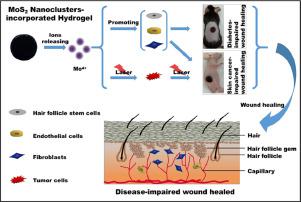Applied Materials Today ( IF 7.2 ) Pub Date : 2020-06-27 , DOI: 10.1016/j.apmt.2020.100735 Bing Ma , Wentao Dang , Zhibo Yang , Jiang Chang , Chengtie Wu

|
Disease-impaired wound healing is one of the most challenging issues clinically, which requires the migration, proliferation and differentiation of multiple types of skin cells, and overcomes the disease-associated problems. To achieve this goal, we set out to firstly synthesize MoS2 (MS) nanoclusters and then to incorporate them into sodium alginate (SA) hydrogel to prepare SA-MS hydrogel as a kind of MoS2 nanoclusters-based biomaterial. The prepared SA-MS hydrogel demonstrates porous microstructure and uniform distribution of Mo elements. The released Mo4+ ions from SA-MS hydrogel exhibit distinct effects on the promotion of the migration and proliferation of human dermal fibroblasts cells (HDFs), human umbilical vein endothelial cells (HUVECs) and human hair dermal papilla cells (HhDPCs) and significantly up-regulated the expression of specific genes in HUVECs and HhDPCs in vitro. SA-MS hydrogel has significant effect on promoting angiogenesis around the wound bed and regeneration of hair follicles of diabetes-impaired wound in C57BL/6 mice diabetic model in vivo by the released Mo4+ ions. Besides, SA-MS hydrogel successfully suppressed skin cancer and realized the skin cancer-impaired wound healing of melanoma-bearing nude mice by the excellent photothermal performance of SA-MS hydrogel in combination of the stimulatory effect of the released Mo4+ ions. Therefore, the prepared SA-MS hydrogel may be one of the promising candidates for disease-impaired wound healing and provides a broad prospect for the development of skin regeneration in the future.
The prepared SA-MS hydrogel releases Mo4+ ions to promote the migration and proliferation of HDFs, HVUECs, and HhDPCs. Moreover, the released Mo4+ ions have a significantly promoted role for the diabetes-impaired wound healing and combine with the photothermal performance of the SA-MS hydrogel to affect the healing of skin cancer impaired wound. Eventually, achieve the role of wound healing by promoting angiogenesis and hair follicle regeneration at the wound bed. Therefore, SA-MS hydrogels have an excellent ability of promoting healing for disease-impaired wound.
中文翻译:

基于MoS 2纳米簇的生物材料,用于疾病受损的伤口治疗
疾病损害的伤口愈合是临床上最具挑战性的问题之一,它需要多种类型皮肤细胞的迁移,增殖和分化,并克服了与疾病相关的问题。为了实现这一目标,我们首先要合成MoS 2(MS)纳米团簇,然后将它们掺入藻酸钠(SA)水凝胶中,以制备SA-MS水凝胶作为一种基于MoS 2纳米团簇的生物材料。制备的SA-MS水凝胶显示出多孔的微观结构和Mo元素的均匀分布。发行的Mo 4+SA-MS水凝胶中的离子对促进人皮肤成纤维细胞(HDF),人脐静脉内皮细胞(HUVEC)和人毛真皮乳头细胞(HhDPC)的迁移和增殖具有明显的作用,并显着上调表达HUVECs和HhDPCs体外特异基因的表达Apoptosis 。SA-MS水凝胶通过释放的Mo 4+在体内促进C57BL / 6糖尿病模型的糖尿病患者创面周围血管新生和糖尿病受损伤口的毛囊再生。离子。此外,SA-MS水凝胶通过结合释放的Mo 4+离子的刺激作用,具有优异的光热性能,成功抑制了皮肤癌,并实现了荷黑素瘤裸鼠皮肤癌的伤口愈合。因此,制备的SA-MS水凝胶可能是有疾病的伤口愈合的有前途的候选者之一,并为将来皮肤再生的发展提供了广阔的前景。
制备的SA-MS水凝胶释放Mo 4+离子,从而促进HDF,HVUEC和HhDPC的迁移和增殖。此外,释放的Mo 4+离子在糖尿病受损的伤口愈合中具有明显的促进作用,并与SA-MS水凝胶的光热性能相结合,可影响皮肤癌受损的伤口的愈合。最终,通过促进伤口床处的血管生成和毛囊再生来达到伤口愈合的作用。因此,SA-MS水凝胶具有优异的促进疾病受损伤口愈合的能力。











































 京公网安备 11010802027423号
京公网安备 11010802027423号